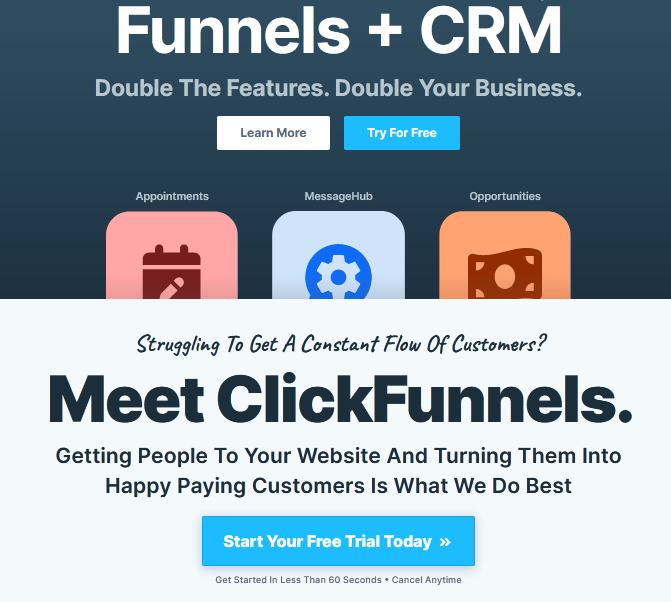ActiveCampaign vs TinyEmail: Which is Best in 2024?
In this review, I’ll be comparing two major email marketing software – ActiveCampaign vs TinyEmail.I’ll cover their pros and cons of each, key features, and which tool you should choose based on your preferences.
Email marketing offers the best return on investment, making $38 for every $1 spent. With 1.5 billion active Gmail users,all of them could be potential customers.
But the real question is: which email marketing software is best? Is it ActiveCampaign or TinyEmail?
In this article, we delve into a point-by-point comparison of ActiveCampaign vs TinyEmail.
So you can pick the best one for you based on your needs!
ActiveCampaign and TinyEmail overview:
ActiveCampaign:
This email marketing platform that helps you send personalized emails, create landing pages, and manage your contacts easily. It’s great for running email campaigns, engaging with your audience, and saving time by automating your marketing tasks.
KEY FEATURE:
- Landing page builder.
- Visual editor.
- Landing page templates.
- Mobile responsive pages.
- A/B Split Testing.
- Email Auto-responders.
- Use your own domain.
- Customer Support:With ActiveCampaign, you can benefit from personalized one-on-one training and their helpful support team is ready to assist you anytime.
- Free migration:Enjoy a worry-free experience with free migration, ensuring no data loss or starting from scratch.
- Forms:Create eye-catching newsletters and campaigns to engage customers and boost sales.
- Welcome series:Set up welcome series and keep customers updated on products and sales.
- Analytics:Use Site Tracking to understand website interactions and enhance your conversion rate.
TinyEmail:
TinyEmail is a powerful tool for email marketing. It has customizable templates, tracks URLs, and offers detailed analytics.
Using AI, it creates personalized emails for different audiences, making your email campaigns more effective and engaging.
KEY FEATURES:
- AI automation:TinyEmail simplifies email marketing with automation features. By setting up triggers and workflows, you can save time and effort, using your existing brand data.
- Customizable Email Templates: It offers customizable templates and a user-friendly drag-and-drop email editor.
- Drag-and-Drop Email Editor: Additionally, you can create forms and landing pages to grow your email list.
- Email Personalization: Personalize your emails easily using subscriber information for more engaging communication.
- Analytics:The built-in email performance tracker provides detailed analytics, while segmentation helps target specific subscriber groups, boosting engagement and reducing email fatigue. With TinyEmail, your email campaigns are efficient and effective.
Point by Point Comparison.
Let’s start with a step-by-step comparison of ActiveCampaign vs TinyEmail:
- Sign Up Process
- Email Marketing Automation
- Design and Flexibility
- Segmentation and List Management
- Reporting and Analytics
- Pricing
1.SIGN UP PROCESS:
TINYEMAIL:
To try tinyEmail out, you’ll need to provide your credit card details And only a 7 days free trial. This might be a bit inconvenient, considering that most email marketing services no longer require this step.
ACTIVECAMPAIGN:
In ActiveCampaign, a free trial is offered, with a more generous 14-day period, and your credit card details don’t have to be provided (thankfully).
Just by entering your email and a password, and providing a few details about your business, you’ll be right in the platform within seconds.
During the free trial period, you can send 100 emails to up to 100 subscribers and access email marketing and CRM features.
The only features not available are predictive sending, predictive content, auto-responder campaigns, form custom fields, and SMSes.
WINNER: ACTIVE CAMPAIGN
Because the overall sign-up process is much quicker with ActiveCampaign. And no need to require a credit card.
2.Email Marketing automation:
If you’re thinking about sending automated emails, ActiveCampaign is the top choice. The platform offers a variety of customizable automated workflows.
ActiveCampaign provides “automation recipes,” which are pre-made templates that users can easily customize with their own content, fields, and tags.
ActiveCampaign’s advanced automation capabilities are accompanied by a vast array of automation ‘recipes’ to assist you in getting started.
If a unique approach is what you are looking for, there’s the flexibility to craft automations from the ground up. Automations can have many triggers, and you can do split tests to find the best pathways.
The platform also supports complex marketing automations like triggered campaigns (sending relevant emails when someone views a specific page on your website), dynamic email content, and automated segmentation.
Additionally, with ActiveCampaign’s bundled Sales and Marketing plan, users can integrate various channels into their automations, including sales follow-ups and SMS.
However, the more advanced e-commerce and lead scoring automations are available in the higher-tiered Plus plan (which we’ll discuss shortly).
In contrast, tinyEmail’s marketing automation options are quite limited. You only have a few basic options, such as welcome, thank you, and abandoned cart emails.
There’s no way to create an automation from scratch or customize the existing ones with tinyEmail.
They simply activate when someone takes a relevant action, without allowing you to define the specific action. Editing the emails doesn’t seem possible either, at least from our observation.
It’s important to mention that ecommerce automations like the abandoned cart email and product review request are currently exclusive to Shopify stores.
They aren’t accessible for stores hosted on other platforms. In contrast, ActiveCampaign supports integrations with WooCommerce, BigCommerce, and more, giving it a significant advantage in this area.
Winner:
Active campaign because it has a lot of customizable automated workflows.
3.Design templates :
ActiveCampaign provides great flexibility for email design. You can create emails from scratch, use a blank layout, upload your own template, or choose from their 240+ pre-designed templates if you need inspiration.
The email editor allows you to customize each template with your branding, images, and text, and you can easily adjust styling like colors, fonts, and spacing.
A bonus is the ability to customize font and button sizes for mobile viewing directly within the editor, without any coding needed.
While ActiveCampaign offers 240+ templates, tinyEmail has an impressive library of 600+ templates, a remarkable feat for a newer tool.
Like with ActiveCampaign, you can adjust your email’s content and styling in tinyEmail. They also allow customization for mobile, taking inspiration from ActiveCampaign’s editing options.
Plus, if none of their templates suit your needs, you can upload your own HTML templates.
Winner : obviously, tinyEmail has more templates than ActiveCampaign, but it’s editing and customization options are nearly identical, like a direct copy and paste.
4.Segmentation feature:
tinyEmail offers advanced segmentation features, allowing you to create custom segments based on various conditions and use AI-powered “recommended segments” to group subscribers with shared characteristics.
This makes sending targeted messages, like re-engagement campaigns or birthday vouchers, easy and efficient, saving you time and ensuring relevance. You can also track engagement within segments.
ActiveCampaign goes further, enabling segment creation using tags, event data (like specific webpage visits), and deal stage.
Moreover, you can personalize emails with conditional content, showing or hiding products based on previous interests. Additionally, it offers a lead scoring feature to rank and prioritize leads based on different actions and criteria.
Winner : because ActiveCampaign’s segmentation options are much more advanced.
5.Reporting and Analytics:
tinyEmail provides helpful reports, including a dashboard summarizing your overall performance. You can see engagement metrics like clicks and opens, as well as campaign deliverability to monitor spam complaints (ideally, aiming for 0%).
At a campaign level, all the regular KPIs like opens, clicks, and unsubscribes, as well as insights into the geographical location of your audience can be viewed.
However, it doesn’t provide extensive insights. In comparison, ActiveCampaign’s reporting features are impressive.
In addition to standard email reports, advanced insights into email client trends and open/read trends are available, along with features like click-maps and page visit tracking.
A notable feature is the “Recommendations for you” section, which proactively suggests actionable steps for optimizing your campaigns.
The reports in ActiveCampaign cover everything from monitoring contact trends and tracking deal progress to analyzing automation performance.
For ecommerce businesses, there are specialized reports for platforms like Shopify, BigCommerce, and WooCommerce, offering detailed insights into online sales metrics.
However, if you require the highest level of flexibility in reporting, custom reporting is only available in the costly Enterprise plan.
6.Price:
As you’ve likely noticed, ActiveCampaign and tinyEmail each bring their unique flavor to the world of email marketing services.
Unsurprisingly, these distinctions extend to the price tags they carry and how they charge for their services.
ActiveCampaign charges based on your list size, allowing unlimited emails regardless of subscribers.
In contrast, tinyEmail charges based on the number of emails you want to send monthly, enabling unlimited contacts. Depending on list size or email frequency, one approach might suit you better than the other.
Due to this difference, a head-to-head comparison is a bit tricky.
However, assuming you want to send 10 emails per month to your subscribers (which is quite a lot!), we can start to understand how vastly different their prices are.
As you can see, tinyEmail is the much cheaper option, especially if you’re sending a small number of emails each month.
It’s essential to note that tinyEmail even offers a free plan with limited features, something ActiveCampaign doesn’t provide.
However, this doesn’t cover the whole story.
These are the basic plans for each provider. To access more advanced features, tinyEmail requires an upgrade to the Pro plan, starting at $65/month, which includes dedicated IP and priority support.
For ActiveCampaign, landing pages, SMS, and ecommerce integrations are available in the Plus plan, starting at $49/month. If you want to use ActiveCampaign’s CRM, you’d need to purchase the bundled Sales and Marketing plan, starting at $93/month.
Winner : In terms of affordability, tinyEmail winner. However, ActiveCampaign offers features that tinyEmail doesn’t, and you’ll need to pay for those extras.
Overall Pros and Cons.
Active campaign and tinyemail both provide extensive features. Here’s a quick breakdown of the pros and cons of Active campaign and tinyemail .
ActiveCampaign Pros and Cons:
Pros:
- A comprehensive feature set, including advanced automation and analytics, is provided.
- High deliverability rates ensure your emails reach the intended recipients.
- Extensive customer support options are available for assistance.
- It can scale easily with the growth of your business.
Cons:
- Beginners might face a steeper learning curve while getting accustomed to the platform.
- The cost may be high for small businesses operating on a budget.
TinyEmail Pros and Cons:
Pros:
- It offers a user-friendly interface, making it ideal for beginners.
- Cost-effective pricing makes it affordable for businesses with limited budgets.
- Basic features are sufficient for straightforward email marketing campaigns.
Cons:
- Limited advanced features and integrations are available.
- Customer support options are less comprehensive compared to other platforms.
- It may not be suitable for large-scale or complex marketing operations.
Final thoughts about activecampaign vs tinyemail:
In the end, choosing between ActiveCampaign and tinyEmail for your email strategy boils down to what fits your business.
ActiveCampaign functions as a versatile sales and marketing tool, covering various channels like email, landing pages, and SMS. It excels in precision targeting through smart automation and segmentation.
Additionally, it integrates smoothly with nearly 1,000 apps, making it a tech-savvy choice. Even if you’re new to email marketing, ActiveCampaign provides ample resources for assistance.
On the other hand, tinyEmail offers simplicity and affordability. Similar to tools like Brevo or MailerLite, it’s great for beginners entering email marketing effortlessly.
While its automation features are basic, the platform is actively working on improvements.


